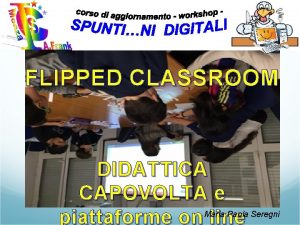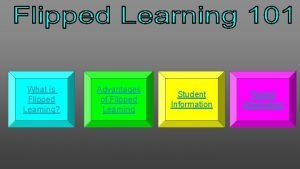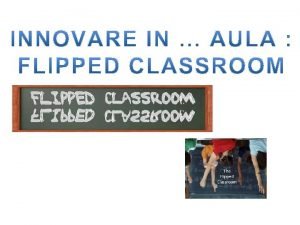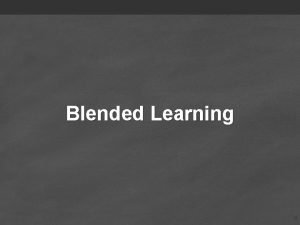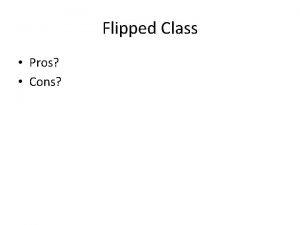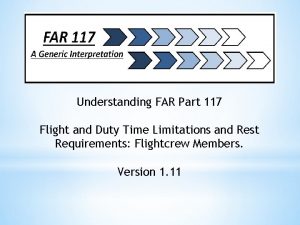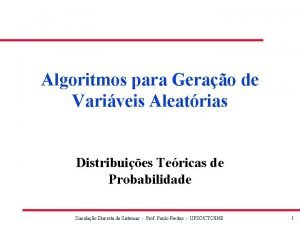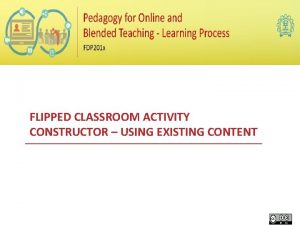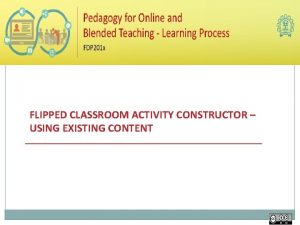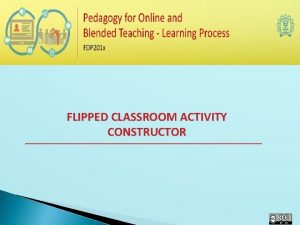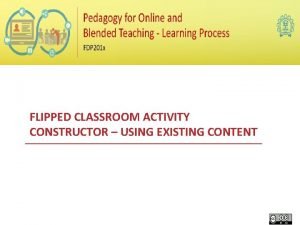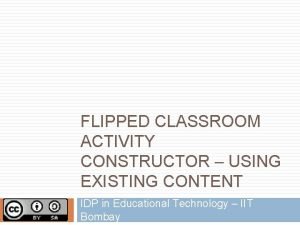FLIPPED CLASSROOM ACTIVITY CONSTRUCTOR USING EXISTING CONTENT FDP

















- Slides: 17

FLIPPED CLASSROOM ACTIVITY CONSTRUCTOR – USING EXISTING CONTENT FDP 201 x RCA-02 Prepared By: Dr. Arun Kumar, Sir Padampat Singhania University, Udaipur IDP in Educational Technology, IIT Bombay

Table of Contents SECTION SLIDE # ABOUT YOU OUT-OF-CLASS SEGMENT IN-CLASS SEGMENT EVALUATION 3 5 -10 11 -16 17 Dr Arun Kumar, Sir Padampat Singhania University, Udaipur IDP in Educational Technology, IIT Bombay 2

About you Provide basic information about yourself and the topic in which you want to design a flipped classroom. I am Dr. Arun Kumar, working as Associate Professor in the department of Computer Science and Engineering at Sir Padamapat Singhania University, Udaipur, Rajasthan, India (www. spsu. ac. in). I want to design a flipped class room activity from the subject Computer Graphics taught at undergraduate level in CSE department on the topic: Two Dimensional Viewing and Clipping Dr Arun Kumar, Sir Padampat Singhania University, Udaipur IDP in Educational Technology, IIT Bombay 3

Replace Header with your Name Two Dimensional Viewing and Clipping Computer Graphics Computer Science and Engineering B. Tech. 5 th semester Sir Padampat Singhania University, Udaipur, Rajasthan Dr Arun Kumar, Sir Padampat Singhania University, Udaipur IDP in Educational Technology, IIT Bombay 4

Out-of-class Activity Design -1 Learning Objective(s) of Out-of-Class Activity 1. Learning about 2 -D window to viewport mapping using application concept. 2. Learning about 2 -D Clipping (Point Clipping and Line clipping) 3. Learning about Cohen Sutherland Line Clipping Algorithm Key Concept(s) to be covered 1. 2. 3. 4. 5. 6. Window to Viewport mapping Normalized device coordinates, Clipping window, Point Clipping, Line Clipping, Cohen Sutherland Line Clipping. Dr Arun Kumar, Sir Padampat Singhania University, Udaipur IDP in Educational Technology, IIT Bombay 5

Out-of-class Activity Design - 2 Main Video Source URL https: //youtu. be/Fwsfx. A 0 Av. Oc https: //youtu. be/GD 4 Qr 6 Iop. CQ Creative Commons license 4. 0(BA-SA) License of Video Mapping Concept to Video Source CONCEPT VIDEO SEGMENT DURATION (in min) Two dimensional Viewing 0. 00 – 10. 57 Two dimensional Clipping 0. 00 -10. 56 TOTAL DURATION 21. 13 minutes Dr Arun Kumar, Sir Padampat Singhania University, Udaipur IDP in Educational Technology, IIT Bombay 6

Out-of-class Activity Design - 2 Main Video Source URL License of Video Mapping Concept to Video Source https: //youtu. be/Fwsfx. A 0 Av. Oc https: //youtu. be/GD 4 Qr 6 Iop. CQ CC-BY-SA (reuse allowed) CONCEPT • Window to Viewport mapping • Normalized device coordinates • Clipping window • Point Clipping • Line Clipping, Cohen Sutherland Line Clipping VIDEO SEGMENT DURATION (in min) Video 1(1. 38 -10. 57) 9. 19 Video 1(10. 28 -10. 49) Video 2(1. 25 -1. 53) Video 2(1. 54 -3. 05) Video 2(3. 06 -10. 36) TOTAL DURATION Dr Arun Kumar, Sir Padampat Singhania University, Udaipur IDP in Educational Technology, IIT Bombay 0. 21 0. 28 1. 51 7. 3 18. 49 min 7

Out-of-class Activity Design - 3 Aligning Assessment with Learning Objective Concept of Window to View Port mapping Solving and understanding the window to view port mapping equation Understanding the concept of clipping, clipping -window, point clipping and line clipping Assessment Strategy Expected duration (in min) (1) Define the terms model, modeling, window, view -port, Scaling factor, view port transformation 3 minutes (2) Numerical question provided in the video-1 4 minutes (3)Define the terms clipping, clipping -window, point clipping and line clipping. 4 minutes 1. Submit this out of class activity by 09/10/2017(Moday) by 5. 30 pm in my chamber or to TA(Mr. Radhey Shyam). 2. (4) Numerical problem given in the video-2 4 minutes Understanding the concept of Cohen Sutherland Line Clipping algorithm (5) Numerical problem given in the video-2 2 minutes 17 minutes Dr Arun Kumar, Sir Padampat Singhania University, Udaipur IDP in Educational Technology, IIT Bombay The 2 nd part of flipped Class is on 10/10/2017(Tuesday) in room no. 04, NCR Block at 10. 30 am. 3. Understanding the concept of point clipping Expected activity duration Additional Instructions (if any) The student must carry the hard copy of the additional material provided(ppts) by downloading from the my MOODLE site. 4. Four marks shall be awarded in the attendance section for submitting the out of class activity in time 8

Out of Class activity Q 1. Define the terms model, modeling, window, view -port, Scaling factor. (2 minutes) Q 2. Define the term window to view-port transformation. (1 minute) Q 3. Given a world window as xwmin=0, xwmax=9, ywmin=0, ywmax=7. There is a rectangle formed inside the world window. You are also given a viewport window on to which this rectangle is to be mapped based on the equations learned earlier in this video. The dimensions of the view port are as follows: xvmin=0, yvmin=0, xvmax=5, yvmax=5. The dimensions of the rectangle are as follows: L(2, 2) and Top right(5, 5). Draw the final shape of the rectangle in the view port with proper coordinates. (4 minutes) Q 4 Define the terms clipping and Clipping window. (2 minutes) Q 5 Define the terms point clipping with respect to clipping window. (2 minutes) Dr Arun Kumar, Sir Padampat Singhania University, Udaipur IDP in Educational Technology, IIT Bombay 9

Out of Class Activity(contd. ) Q 6. Given the size of the clipping window is (xwmin=1, xwmax=7, ywmin=2, ywmax=6). You are given two points A(0. 5, 6) and B(3, 4), find whether the points shall be inside or outside of the window, using point clipping algorithm. (4 minutes) Q 7. Find the region code for the given line P 1 P 2 in the figure(2 minutes) Dr Arun Kumar, Sir Padampat Singhania University, Udaipur IDP in Educational Technology, IIT Bombay 10

In-class Activity Design -1 Learning Objective(s) of In - Class Activity 1. Applying the knowledge learnt about window to viewport mapping through the video-1 on to an object and generating normalized device coordinates for the said object. 2. Applying point clipping algorithm to identify the inclusion and exclusion of different sets of points given(Video-2 provided) 3. Applying Cohen-Sutherland Line Clipping Algorithm to solve a numerical problem given. (Video-2 provided) Key Concept(s) to be covered 1. Window to viewport mapping, Normalized device co-ordinates, point clipping, line clipping, Cohen Sutherland Line Clipping Dr Arun Kumar, Sir Padampat Singhania University, Udaipur IDP in Educational Technology, IIT Bombay 11

In-class Activity Design -1 Learning Objective(s) of In-Class Activity 1. Applying the fundamentals learnt through the videos(Video-1 and Video 2) provided earlier and the out-of-class activity assignment on to solving numerical and conceptual problems based on the concepts of 2 D viewing and clipping and also Cohen Sutherland Line Clipping algorithm. Key Concept(s) to be covered § § Use of window to view port mapping to real time objects Use of point Clipping and Cohen-Sutherland line Clipping algorithm to a real set of lines given. Dr Arun Kumar, Sir Padampat Singhania University, Udaipur IDP in Educational Technology, IIT Bombay 12

In-class Activity Design -2 Active Learning activity(ies) that you plan to do 1. The active learning strategy adopted is TPS(Think-Pair-Share) Explain the strategy by giving details of 1. What Teacher will do? The teacher shall pose two questions to the students and give them time to solve individually(for ~10 minutes) and ask them to form a pair and compare your answers with the other member of the pair after proper discussion(for ~7 minutes). After that the class has to share their view and answers with the rest of the pairs of the class(for ~5 minutes) 1. What Student will do? The students have been given ~10 minutes of time to solve the problems individually and then for the next ~7 minutes have to discuss with the other partner in the pair and then finally for the next ~5 minutes have to discuss with the rest of the class and provide justification for their answers. Justify why the above is an active learning strategy 1. Enter Justification Here Think –Pair –Share is an active learning strategy in which the students are provided with written documents and or a video about a particular topic before hand , so that the student applies his or her brain to understand the topic and then attempts some basic questions over such a topic and submits the out of class assignment and joins the in class activity on the scheduled day. The teacher asses the out of class assignment and comes to know about the problems faced by the students and discusses them before the in-class activity and then starts the in class activity by providing two questions to be solved individually first and then sharing with partners and then wit the rest of the class. This improves the overall learning of the student and develops an ability to self learn and then compare and share. In our case the students applied their brain and if minor mistakes were they were corrected at the pair end and finally during the share round , the confidence of the students got boosted up when the answers were compared. Dr Arun Kumar, Sir Padampat Singhania University, Udaipur IDP in Educational Technology, IIT Bombay 13

In-class Activity Design -2 Peer Instruction Strategy – What Teacher Does Place this question to the students as in class activity. Q 1: Find the normalization transformation that maps a window whose lower left corner is at (1, 1) and upper right corner is at (3, 5) onto A view port that is the entire normalized device screen, and A viewport that has a lower left corner at (0, 0) and upper right corner (1/2, 1/2). Dr Arun Kumar, Sir Padampat Singhania University, Udaipur IDP in Educational Technology, IIT Bombay 14

In-class Activity Design -2 Peer Instruction Strategy – What Teacher Does Place this question to the students as in class activity. Q 2: Find the complete viewing transformation that maps a window in the world coordinates with x extent 1 to 10 and y extent 1 to 10 onto a viewport with x extent ¼ to ¾ and y extent 0 to ½ in normalized device space, and then maps a workstation window with x extent ¼ to ½ and y extent ¼ to ½ in the normalized device space in to work station viewport with x extent 1 to 10 and y extent 1 to 10 on the physical display device. Dr Arun Kumar, Sir Padampat Singhania University, Udaipur IDP in Educational Technology, IIT Bombay 15

In-class Activity Design -3 Peer Instruction Strategy – What Teacher Does Q 3) Let R be the rectangular window whose lower left hand corner is at L(-3, 1) and upper right hand corner is at R(2, 6). Find the region codes for the end points using Cohen Sutherland Line Clipping algorithm, also find the intersection points with the boundary of the window. Display your results with a final drawing of the clipped lines. AB(-4, 2), (-1, 7) CD(-1, 5), (3, 8) EF(-2, 3), (1, 2) GH(1, -2), (3, 3) IJ(-4, 7), (-2, 10) Dr Arun Kumar, Sir Padampat Singhania University, Udaipur IDP in Educational Technology, IIT Bombay 16

Evaluation The out of class activity has been kept as a graded assignment for four marks and shall be allotted during the end term-examination. Therefore submission of out-of-class activity is compulsory for all the students. The due date for the submission of out-of-class activity is 09/10/2017(5. 30 pm). The in-class activity shall take place on 10/10/2017(10. 30 am) at NCR-04. Dr Arun Kumar, Sir Padampat Singhania University, Udaipur IDP in Educational Technology, IIT Bombay 17
 Paola seregni
Paola seregni Flipped classroom advantages and disadvantages
Flipped classroom advantages and disadvantages Venitemi dietro con l'occhio significato
Venitemi dietro con l'occhio significato Moodle meg
Moodle meg Flipped classroom schema
Flipped classroom schema Bioengineering flipped classroom
Bioengineering flipped classroom Flipped classroom
Flipped classroom Flipped classroom examples
Flipped classroom examples Flipped classroom pros and cons
Flipped classroom pros and cons Fdp table b
Fdp table b Ine22 são paulo
Ine22 são paulo Ordering fractions decimals and percents
Ordering fractions decimals and percents Fdp expanded clearinghouse
Fdp expanded clearinghouse Fdp wahlplakat entnazifizierung
Fdp wahlplakat entnazifizierung Osp gmu
Osp gmu Fdp designation
Fdp designation Cse smart class
Cse smart class What does a content mastery teacher do
What does a content mastery teacher do
